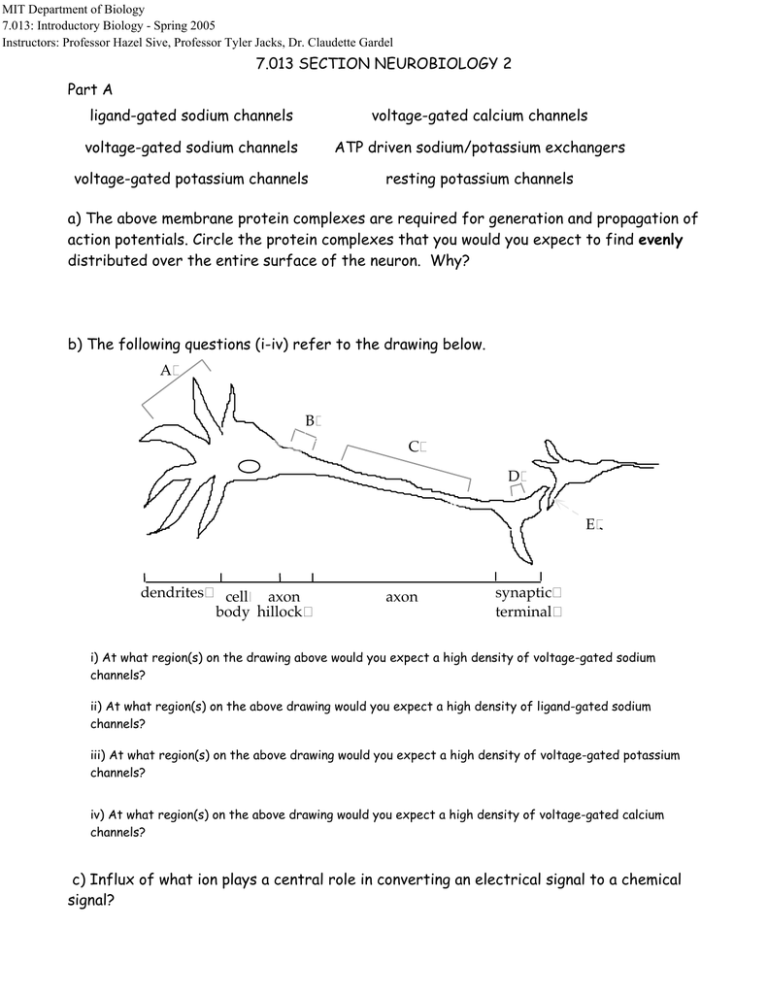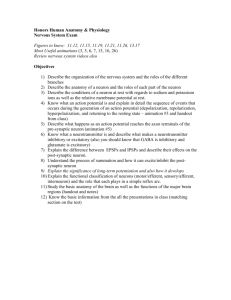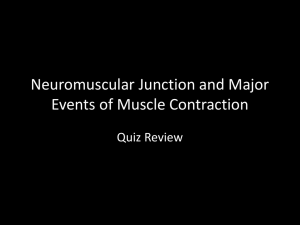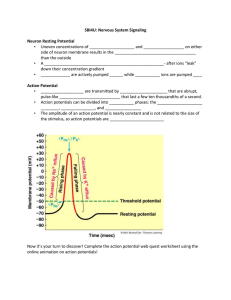MIT Department of Biology 7.013: Introductory Biology - Spring 2005
advertisement

MIT Department of Biology 7.013: Introductory Biology - Spring 2005 Instructors: Professor Hazel Sive, Professor Tyler Jacks, Dr. Claudette Gardel 7.013 SECTION NEUROBIOLOGY 2 Part A ligand-gated sodium channels voltage-gated calcium channels voltage-gated sodium channels ATP driven sodium/potassium exchangers voltage-gated potassium channels resting potassium channels a) The above membrane protein complexes are required for generation and propagation of action potentials. Circle the protein complexes that you would you expect to find evenly distributed over the entire surface of the neuron. Why? b) The following questions (i-iv) refer to the drawing below. A B C D E dendrites cell axon body hillock axon synaptic terminal i) At what region(s) on the drawing above would you expect a high density of voltage-gated sodium channels? ii) At what region(s) on the above drawing would you expect a high density of ligand-gated sodium channels? iii) At what region(s) on the above drawing would you expect a high density of voltage-gated potassium channels? iv) At what region(s) on the above drawing would you expect a high density of voltage-gated calcium channels? c) Influx of what ion plays a central role in converting an electrical signal to a chemical signal? d) Outline the steps involved in neuotransmitter release after the action potential invades the terminal of the pre-synaptic cell. e) What would happen if the presynaptic neuron in d) were exposed to Ca2+ channel blockers? Acetylcholine (abbreviated ACh) is one of the most common neurotransmitters in both invertebrates and vertebrates. Its function is varied. At the neuromuscular junction, acetylcholine is released from the terminal of a presynaptic motor axon. The effect on the postsynaptic skeletal muscle cell is excitatory. In the heart, however, acetylcholine can be inhibitory, so that it slows the heart rate. f) How can the same neurotransmitter trigger the opposite responses in different cell types? To study the function of ACh, one can isolate an entire neuromuscular junction. You can study synaptic transmission by wrapping a wire around the presynaptic neuron, stimulating it with an electrical current, and then measuring the effects of this stimulation in the postsynaptic muscle cell. You can also apply ACh directly onto the muscle cell to get the same effect. g) In your studies you find that ACh receptors are localized to a specific point in the muscle cell. (Applying ACh elsewhere on the muscle has no effect.) Where on the muscle cell would ACh receptors need to be to function properly? Part B You are doing electrophysiological recordings on a neuron innervating muscle fiber as shown. The neuromuscular juction is an acetylcholinergic synapse between the neuron and the muscle fiber. You are injecting current through the “Stimulus” electrode and taking recordings from the other electrodes, labeled 1 and 2 placed in the positions shown. 1 A Stimulus B Muscle 2 C D E a) In normal medium, you stimulate the neuron and see recordings in 2 that look like A. i) What do you see in electrode 1? A B C D E ii) What will occur in the muscle? no contraction contraction spasm b) Textilotoxin blocks acetylcholine release. If you were to perfuse with medium containing textilotoxin from the Australian common brown snake, upon stimulation, what would…. i) …you see in electrode 2? A B C D E ii) …occur in the muscle? no contraction contraction spasm c) Tetrodotoxin acts by blocking voltage-gated Na+ channels. If you were to perfuse with medium containing tetrodotoxin taken from the fugu pufferfish, which is a delicacy to thrill seekers of East Asia, upon stimulation, what would… i) …you see in electrode 2? A B C D E ii) …occur in the muscle? no contraction contraction spasm d) Dendrotoxin K acts by blocking voltage-gated K+ channels. If you were to perfuse with medium containing dendrotoxin K taken from the deadly black mamba, namesake of “Kill Bill’s” The Bride, upon stimulation, what would… i) … you see in electrode 2? A B C D E ii) … occur in the muscle? no contraction contraction spasm e) Latrotoxin acts by enhancing acetylcholine release. If you were to perfuse with medium containing latrotoxin, taken from the black widow spider, upon stimulation, what would … i) …you see in electrode 2? A B C D E ii) …occur in the muscle? no contraction contraction spasm f) Agatoxin acts by blocking Ca++ channels. If you were to perfuse with medium containing agatoxin, taken from the funnel web spider, upon stimulation, what would … i) …you see in electrode 2? A B C D E ii) …occur in the muscle? no contraction contraction spasm Part C You create the following arrangement of cells in vitro. Neuron 1 Neuron 2 Neuron 3 Neuron 4 Neuron 5 Inhibitory Neuron 6 The large neuron receives 4 synaptic inputs from cells 1-4 that are identical in every way except for their location. Each neuron releases the same amount of neurotransmitter when stimulated. • When neuron 1 is stimulated, the post-synaptic cell does not fire an action potential. • When neuron 3 is stimulated, the post-synaptic cell fires an action potential. a) When neuron 4 is stimulated, would you predict that an action potential is generated in the post-synaptic cell? Explain why or why not. b) What would determine whether neuron 2 would result in an action potential in the post-synaptic cell? c) When an inhibitory neuron is stimulated and releases neurotransmitter, neurotransmitter binds to and opens ion channels on the post-synaptic cell. What ion might move through these channels? What is the effect on the post-synaptic cell? d) Neuron 5 releases only one kind of neurotransmitter, and synapses onto two distinct cell types. Circle the statements that are true. • The neurotransmitter released by neuron 5 could be excitatory at both synapses. • The neurotransmitter released by neuron 5 could be inhibitory at both synapses. • The neurotransmitter released by neuron 5 could be inhibitory at one synapse and excitatory at the other. • The neurotransmitter receptors on the post-synaptic cells could be the same as each other. • The neurotransmitter receptors on the post-synaptic cells could be different from each other. • The neurotransmitter released by neuron 5 at one synapse could diffuse and affect the other synapse.





